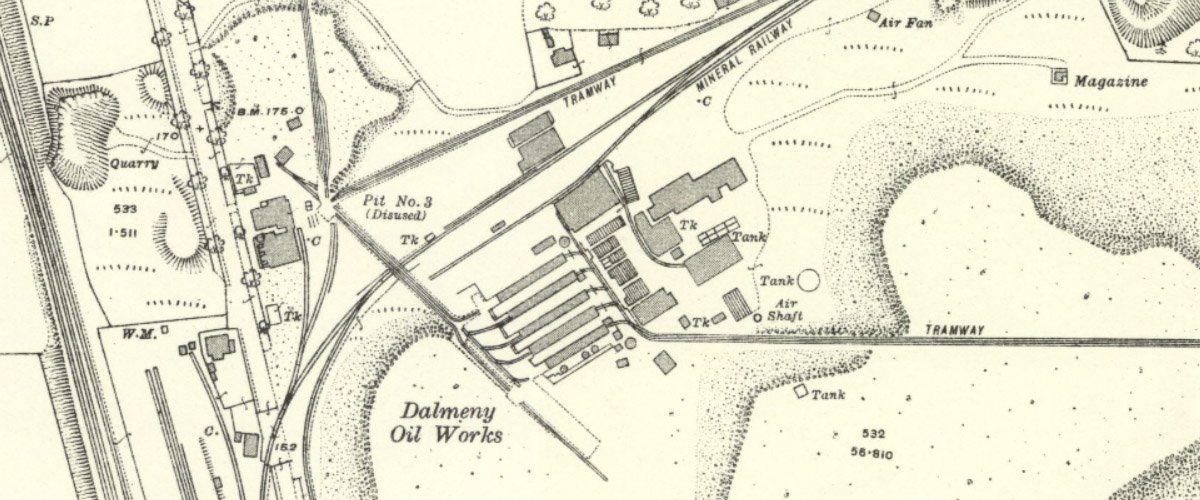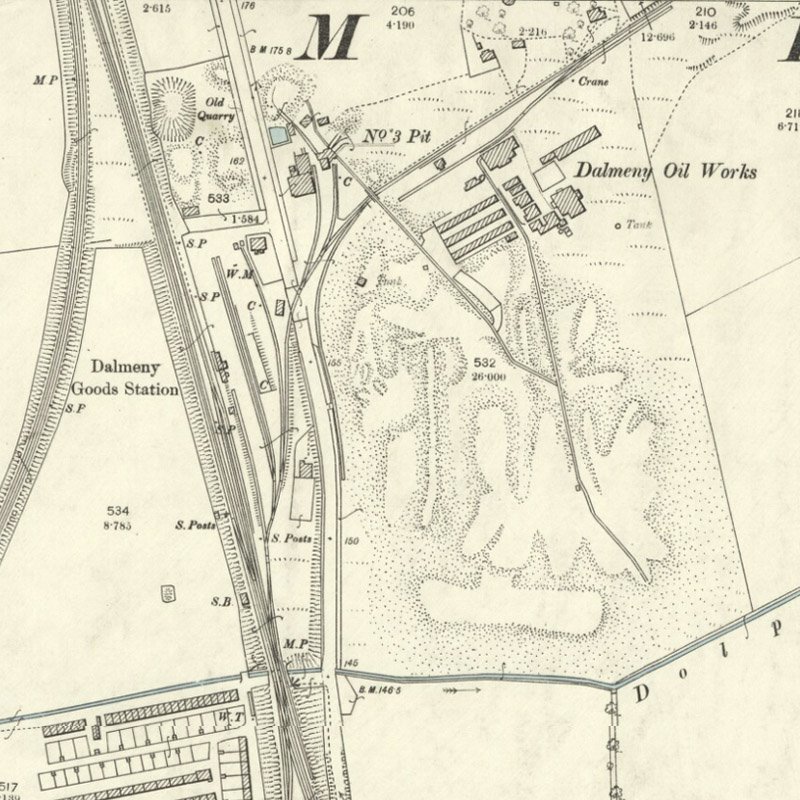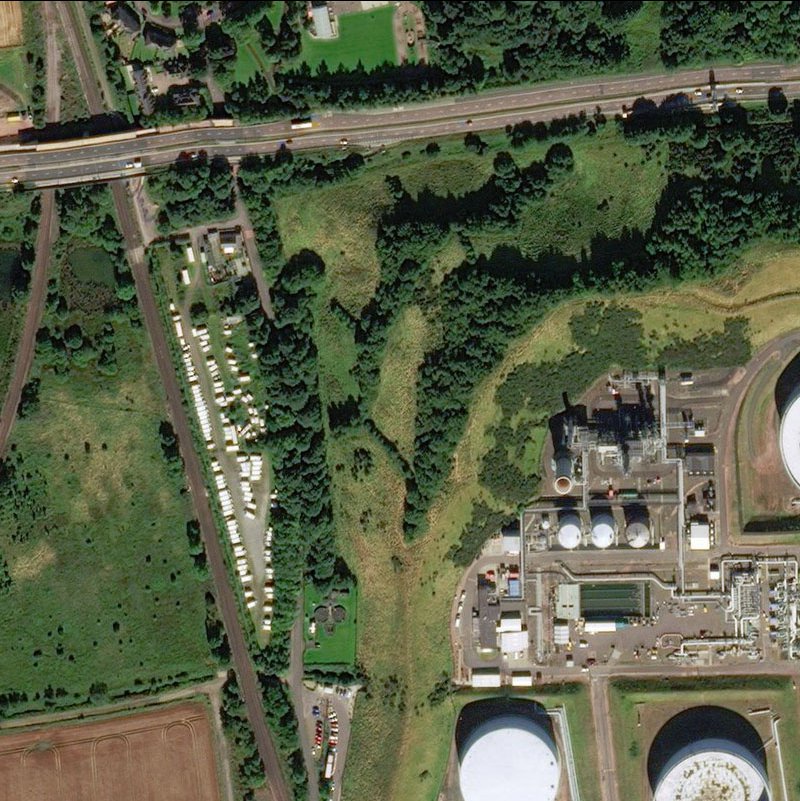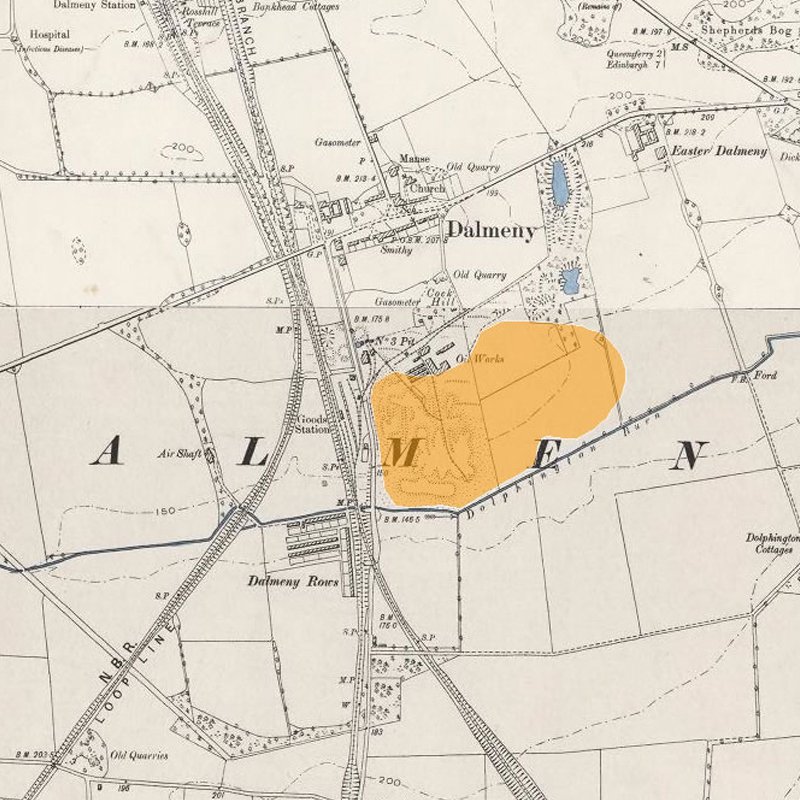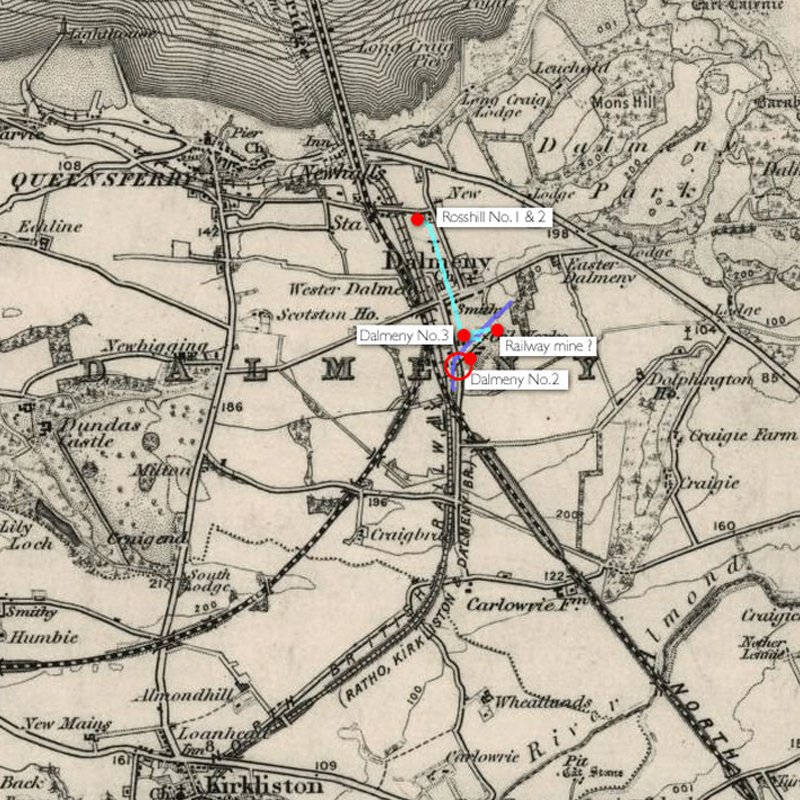- Aberdeen Oil Works
- Addiewell Oil Works
- Almondhill Oil Works
- Annick Lodge Oil Works
- Arden Oil Works
- Armadale Oil Works
- Auchenheath Oil Works
- Avonhead Oil Works
- Balgray Oil Works
- Ballat Oil Works
- Bathgate Oil Works
- Bathville Oil Works
- Bellsdyke Oil Works
- Bellsquarry Oil Works
- Benhar Oil Works
- Binnend Oil Works
- Birkenshaw Oil Works
- Bishop Street Oil Works
- Blackburn Oil Works
- Blackstone Oil Works
- Blackstoun Oil Works
- Blochairn Oil Works
- Boghall Oil Works
- Bredisholm Oil Works
- Breich Oil Works
- British Asphalte Oil Works
- Broxburn Oil Works
- Broxburn - Bell's Stewartfield Oil Works
- Broxburn - Albyn Oil Works
- Broxburn - East Mains Oil Works
- Broxburn - Greendykes Oil Works
- Broxburn - Hallfarm Oil Works
- Broxburn - Hutchinson's Oil Works
- Broxburn - Poynter's Oil Works
- Broxburn - Steele's Oil Works
- Broxburn - Steele's Stewartfield Oil Works
- Buckside Oil Works
- Burngrange Oil Works
- Calderbank Oil Works
- Canalbank Oil Works
- Champfleurie Oil Works
- Clippens Oil Works
- Cobbinshaw North Oil Works
- Cobbinshaw South Oil Works
- Coneypark Oil Works
- Craigie Oil Works
- Crown Point Oil Works
- Dalmeny Oil Works
- Deans Oil Works
- Doura Oil Works
- Drumbow Oil Works
- Drumcross Oil Works
- Drumgray Oil Works
- Dryflat Oil Works
- East Fulton Oil Works
- East Hermand Oil Works
- Eldin Oil Works
- Falkirk Oil Works
- Fergushill Oil Works
- Forthbank Oil Works
- Forth & Clyde Oil Works
- Gavieside Oil Works
- Grange Oil Works
- Grangepans Oil Works
- Greengairs Oil Works
- Hareshaw Oil Works
- Hartwood Oil Works
- Hawick Oil Works
- Hermand Oil Works (1866)
- Hermand Oil Works (1883)
- Holmes Oil Works
- Hopetoun Oil Works
- Hurlford Oil Works
- Inkerman Oil Works
- Inverkeithing Oil Works
- Kilrenny Oil Works
- Kilwinning Oil Works
- Kirkmuirhill Oil Works
- Kirkwood Oil Works
- Lanark Oil Works
- Lanemark Oil Works
- Levenseat Oil Works
- Limerigg Oil Works
- Linwood Oil Works
- Loanhead Oil Works
- Lochburn Road Oil Works
- Lochgelly Oil Works
- Longrigg Oil Works
- Magdalene Oil Works
- Methil Oil Works
- Millburn Oil Works
- Nettlehole Oil Works
- Niddry Castle Oil Works
- Nitshill Oil Works
- Oakbank Oil Works
- Palacecraig Oil Works
- Pathhead Oil Works
- Patterton Oil Works
- Pentland Oil Works
- Philpstoun Oil Works
- Port Dundas Oil Works
- Possil Oil Works
- Pumpherston Oil Works
- Raebog Oil Works
- Riggend Oil Works
- Rochsoles Oil Works
- Rochsolloch Oil Works
- Roman Camp - Almondfield Oil Works
- Roman Camp - Cawburn Oil Works
- Roman Camp Oil Works (1892)
- Roman Camp - Shale Oil Works
- Rosebank Oil Works
- Roughcraig Oil Works
- Rumford Street Oil Works
- Seafield Oil Works
- Shawsburn Oil Works
- Sheepford Locks Oil Works
- Shettleston Oil Works
- Shotts Oil Works
- Stand Oil Works
- Stanrigg Oil Works
- Stonehouse Oil Works
- Straiton Oil Works
- St. Rollox Works
- Swinehill Oil Works
- Tarbrax Oil Works
- Uphall Oil Works
- Uphall - Railway Oil Works
- Uphall - Wyllie's Oil Works
- Vulcan Chemical Works
- Wardend Oil Works
- Wattston Oil Works
- Westfield & Capeldrae Oil Works
- Westwood Oil Works (1941)
- Westwood Oil Works (1866)
- Whitebog Oil Works
- Whitehill Oil Works (Lanarkshire)
- Whitehill Oil Works (Midlothian)
- Whiterigg Oil Works
- Woodhall Oil Works
Dalmeny Oil Works
A substantial crude oil works exploiting local oil-shales. Less than two years after construction of the oil works, a public limited company (The Dalmeny Oil Company Ltd) was formed to take over the interests of the business. A close working relationship later developed with the Oakbank Oil Company Ltd, who refined much of Dalmeny's crude, and ultimately owned the majority of the company's shares. Following the formation of Scottish Oils Ltd, much of the shale produced at the Ingliston pits were transported to Dalmeny for retorting.
Redwood commented "This company has been a phenomenal success, and as it has always been a crude oil work only, and has not had any special advantages as regards shale fields, &c., it points to the fact that there is not much profit in refining unless done on a sufficiently large scale; and if some of the other ventures had followed the Dalmeny Company's example, and stuck to the crude oil business and left the refining to those more capable of doing it, it would have been better for all concerned."
Retorts
36 retorts "of and improved design" erected in 1898, with further benches of 40 retorts each in 1899 and 1900.
| Date | Rateable Value | Owner | Occupier | Notes |
| 1870 | £500 | Earl of Roseberry | Robert & Alex Pattison | Minerals |
| 1871 | £164.15 | Earl of Roseberry | Dalmeny Oil Company Ltd | Works |
| £700 | Earl of Roseberry | Dalmeny Oil Company Ltd | Minerals | |
| 1872 | £700 | Earl of Roseberry | Dalmeny Oil Company Ltd | Works |
| £1016.15/- | Earl of Roseberry | Dalmeny Oil Company Ltd | Minerals | |
| 1873 | £1016.15/- | Earl of Roseberry | Dalmeny Oil Company Ltd | Works |
| £1282.10/- | Earl of Roseberry | Dalmeny Oil Company Ltd | Minerals | |
| 1874 | £457.10/- | Earl of Roseberry | Dalmeny Oil Company Ltd | Works |
| £1296.10/- | Earl of Roseberry | Dalmeny Oil Company Ltd | Minerals | |
| 1875 | £457.10/- | Earl of Roseberry | Dalmeny Oil Company Ltd | Works |
| £1205.5/- | Earl of Roseberry | Dalmeny Oil Company Ltd | Minerals | |
| 1876 | £457.10/- | Earl of Roseberry | Dalmeny Oil Company Ltd | Works |
| £1031 | Earl of Roseberry | Dalmeny Oil Company Ltd | Minerals | |
| 1877 | £457.10/- | Earl of Roseberry | Dalmeny Oil Company Ltd | Works |
| £1087 | Earl of Roseberry | Dalmeny Oil Company Ltd | Minerals | |
| 1878 | £457.10/- | Earl of Roseberry | Dalmeny Oil Company Ltd | Works |
| £1178.10/- | Earl of Roseberry | Dalmeny Oil Company Ltd | Minerals | |
| 1879 | £457.10/- | Earl of Roseberry | Dalmeny Oil Company Ltd | Works |
| £1224 | Earl of Roseberry | Dalmeny Oil Company Ltd | Minerals | |
| 1880 | £1000 | Earl of Roseberry | Dalmeny Oil Company Ltd | Works |
| £1342.15/- | Earl of Roseberry | Dalmeny Oil Company Ltd | Minerals | |
| 1881 | £1000 | Earl of Roseberry | Dalmeny Oil Company Ltd | Works |
| £1503.15/2 | Earl of Roseberry | Dalmeny Oil Company Ltd | Minerals | |
| 1882 | £800 | Earl of Roseberry | Dalmeny Oil Company Ltd | Works |
| £1565.3/3 | Earl of Roseberry | Dalmeny Oil Company Ltd | Minerals | |
| 1883 | £1000 | Earl of Roseberry | Dalmeny Oil Company Ltd | Works |
| £1922.13/11 | Earl of Roseberry | Dalmeny Oil Company Ltd | Minerals | |
| 1884 | £1000 | Earl of Roseberry | Dalmeny Oil Company Ltd | Works |
| £2046.13/11 | Earl of Roseberry | Dalmeny Oil Company Ltd | Minerals | |
| 1885 | £1000 | Dalmeny Oil Company Ltd | Dalmeny Oil Company Ltd | Works |
| £2354.12/4 | Earl of Roseberry | Dalmeny Oil Company Ltd | Minerals | |
| 1886 | £1000 | Earl of Roseberry | Dalmeny Oil Company Ltd | Works |
| £2639.1.4 | Earl of Roseberry | Dalmeny Oil Company Ltd | Minerals | |
| 1887 | £1000 | Earl of Roseberry | Dalmeny Oil Company Ltd | Works |
| £2647.2.2 | Earl of Roseberry | Dalmeny Oil Company Ltd | Minerals | |
| 1888 | £1357 | Earl of Roseberry | Dalmeny Oil Company Ltd | Works |
| £2090.4.9 | Earl of Roseberry | Dalmeny Oil Company Ltd | Minerals | |
| 1889 | £1357 | Earl of Roseberry | Dalmeny Oil Company Ltd | Works |
| £1637.6.8 | Earl of Roseberry | Dalmeny Oil Company Ltd | Minerals | |
| 1890 | £1400 | Earl of Roseberry | Dalmeny Oil Company Ltd | Works |
| £2042 | Earl of Roseberry | Dalmeny Oil Company Ltd | Minerals | |
| 1891 | £1400 | Earl of Roseberry | Dalmeny Oil Company Ltd | Works |
| £1730.13.9 | Earl of Roseberry | Dalmeny Oil Company Ltd | Minerals | |
| 1892 | £1490 | Earl of Roseberry | Dalmeny Oil Company Ltd | Works |
| £1000 | Earl of Roseberry | Dalmeny Oil Company Ltd | Minerals | |
| 1893 | £1490 | Earl of Roseberry | Dalmeny Oil Company Ltd | Works |
| £1000 | Earl of Roseberry | Dalmeny Oil Company Ltd | Minerals | |
| 1894 | £1700 | Earl of Roseberry | Dalmeny Oil Company Ltd | Works |
| £1000 | Earl of Roseberry | Dalmeny Oil Company Ltd | Minerals | |
| 1895 | £1700 | Earl of Roseberry | Dalmeny Oil Company Ltd | Works |
| £2115.2.5 | Earl of Roseberry | Dalmeny Oil Company Ltd | Minerals | |
| 1896 | £1700 | Earl of Roseberry | Dalmeny Oil Company Ltd | Works |
| £2907.12.4 | Earl of Roseberry | Dalmeny Oil Company Ltd | Minerals | |
| 1897 | £1680 | Earl of Roseberry | Dalmeny Oil Company Ltd | Works |
| £2597.6.2 | Earl of Roseberry | Dalmeny Oil Company Ltd | Minerals | |
| 1898 | £1850 | Earl of Roseberry | Dalmeny Oil Company Ltd | Works |
| £2597.6.2 | Earl of Roseberry | Dalmeny Oil Company Ltd | Minerals | |
| 1899 | £1850 | Earl of Roseberry | Dalmeny Oil Company Ltd | Works |
| £1793.0.2 | Earl of Roseberry | Dalmeny Oil Company Ltd | Minerals | |
| 1900 | £1850 | Earl of Roseberry | Dalmeny Oil Company Ltd | Works |
| £1145.11.11 | Earl of Roseberry | Dalmeny Oil Company Ltd | Minerals | |
| 1901 | £2400 | Earl of Roseberry | Dalmeny Oil Company Ltd | Works |
| £1769.7/4 | Earl of Roseberry | Dalmeny Oil Company Ltd | Minerals | |
| 1902 | £2780 | Earl of Roseberry | Dalmeny Oil Company Ltd | Works |
| £2097.10/6 | Earl of Roseberry | Dalmeny Oil Company Ltd | Minerals | |
| 1903 | £2780 | Earl of Roseberry | Dalmeny Oil Company Ltd | Works |
| £1639.8/9 | Earl of Roseberry | Dalmeny Oil Company Ltd | Minerals | |
| 1904 | £2780 | Earl of Roseberry | Dalmeny Oil Company Ltd | Works |
| £2007.1/4 | Earl of Roseberry | Dalmeny Oil Company Ltd | Minerals | |
| 1905 | £3500 | Earl of Roseberry | Dalmeny Oil Company Ltd | Works |
| £2700.7/10 | Earl of Roseberry | Dalmeny Oil Company Ltd | Minerals | |
| 1906 | £3500 | Earl of Roseberry | Dalmeny Oil Company Ltd | Works |
| £2929.15/4 | Earl of Roseberry | Dalmeny Oil Company Ltd | Minerals | |
| 1907 | £3100 | Earl of Roseberry | Dalmeny Oil Company Ltd | Works |
| £2727.4/9 | Earl of Roseberry | Dalmeny Oil Company Ltd | Minerals | |
| 1908 | £3100 | Earl of Roseberry | Dalmeny Oil Company Ltd | Works |
| £2768.17/11 | Earl of Roseberry | Dalmeny Oil Company Ltd | Minerals | |
| 1909 | £3100 | Earl of Roseberry | Dalmeny Oil Company Ltd | Works |
| £4103.8/9 | Earl of Roseberry | Dalmeny Oil Company Ltd | Minerals | |
| 1910 | £3100 | Earl of Roseberry | Dalmeny Oil Company Ltd | Works |
| £3239.8/- | Earl of Roseberry | Dalmeny Oil Company Ltd | Minerals | |
| 1911 | £3100 | Earl of Roseberry | Dalmeny Oil Company Ltd | Works |
| £2958.12/6 | Earl of Roseberry | Dalmeny Oil Company Ltd | Minerals Dalmeny | |
| £588.1/6 | J Stewart Clark | Dalmeny Oil Company Ltd | Minerals Dundas | |
| 1912 | £3100 | J Stewart Clark | Dalmeny Oil Company Ltd | Works |
| £2009 | J Stewart Clark | Dalmeny Oil Company Ltd | Minerals Dalmeny | |
| £623.18/9 | J Stewart Clark | Dalmeny Oil Company Ltd | Minerals Dundas | |
| 1913 | £3100 | J Stewart Clark | Dalmeny Oil Company Ltd | Works |
| £1986.10/2 | J Stewart Clark | Dalmeny Oil Company Ltd | Minerals Dalmeny | |
| £529.17/9 | J Stewart Clark | Dalmeny Oil Company Ltd | Minerals Dundas | |
| 1914 | £3100 | J Stewart Clark | Dalmeny Oil Company Ltd | Works |
| £3169.8/7 | J Stewart Clark | Dalmeny Oil Company Ltd | Minerals | |
| £20.18/8 | War Dept. (The Crown) | Dalmeny Oil Company Ltd | Minerals | |
| 1915 | £3100 | War Dept. (The Crown) | Dalmeny Oil Company Ltd | |
| £2459.8/8 | War Dept. (The Crown) | Dalmeny Oil Company Ltd | ||
| £103.5/5 | War Dept. (The Crown) | Dalmeny Oil Company Ltd | ||
| 1916 | £2250 | War Dept. (The Crown) | Dalmeny Oil Company Ltd | |
| £1553.10/9 | War Dept. (The Crown) | Dalmeny Oil Company Ltd | ||
| £103.5/5 | War Dept. (The Crown) | Dalmeny Oil Company Ltd | ||
| 1917 | £2250 | War Dept. (The Crown) | Dalmeny Oil Company Ltd | |
| £1295.0/3 | War Dept. (The Crown) | Dalmeny Oil Company Ltd | ||
| 1918 | £2250 | War Dept. (The Crown) | Dalmeny Oil Company Ltd | |
| £1430.16/4 | War Dept. (The Crown) | Dalmeny Oil Company Ltd | Minerals under sea | |
| £534.18/9 | War Dept. (The Crown) | Dalmeny Oil Company Ltd | ||
| 1919 | £2250 | War Dept. (The Crown) | Dalmeny Oil Company Ltd | |
| £1405.13/2 | War Dept. (The Crown) | Dalmeny Oil Company Ltd | ||
| £250 | War Dept. (The Crown) | Dalmeny Oil Company Ltd | ||
| 1920 | £2250 | War Dept. (The Crown) | Dalmeny Oil Company Ltd | |
| £1202.1/2 | War Dept. (The Crown) | Dalmeny Oil Company Ltd | ||
| £250 | War Dept. (The Crown) | Dalmeny Oil Company Ltd | ||
| 1921 | £2700 | War Dept. (The Crown) | Dalmeny Oil Company Ltd | |
| £1000 | War Dept. (The Crown) | Dalmeny Oil Company Ltd | ||
| £250 | War Dept. (The Crown) | Dalmeny Oil Company Ltd | ||
| 1922 | £2250 | War Dept. (The Crown) | Dalmeny Oil Company Ltd | |
| £500 | War Dept. (The Crown) | Dalmeny Oil Company Ltd | Minerals Unwrought | |
| 1923 | £2250 | War Dept. (The Crown) | Dalmeny Oil Company Ltd | |
| 1924-25 | £2000 | War Dept. (The Crown) | Dalmeny Oil Company Ltd | |
| 1926 | £3000 | War Dept. (The Crown) | Dalmeny Oil Company Ltd | |
| NO FURTHER ENTRIES |
Recent images

The oil works site lies between Dalmeny nursery school and the greened bing on the horizon, immediately south of the M90. Looking south. June 2011.

Closer view. June 2011.

Access to Dalmeny tank farm, serving Hound Point oil terminal, hidden within the hollowed-out bing of the former oil works. Looking east. June 2011.
This COMPANY is being formed for the purpose of acquiring the DALMENY SHALE and OIL WORKS, near Queensferry, with the lease of shale and other minerals in part of the DALMENY ESTATE of the EARL OF ROSEBERRY. The mineral field is intersected by the Queensferry Branch of the North British Railway Company, and the works connected with that branch by a short line of private railway. The extent and contents of the mineral field have been amply proved by mineral workings and by boring. The mining machinery has been completed so as to admit of an output of 200 tons of shale per day, and by a little further expenditure, this can be easily increased. The Oil Works were erected within the last eighteen months and having been gradually extended during that time as the commercial value of the undertaking was proved. They contain 33 upright and 44 horizontal retorts with relative machinery and plant. A relatively small proportion of additional expense will increase the Oil Works, so as to use the output available from the mining plant.
Prospectus in The Scotsman, 2nd October 1871
.......
The Dalmeny Oil Company (Limited). - Near Edinburgh,
Our works are situated on the Dolphington Burn, a tributary of the Water of Leith. Employ 141 hands. Rateable value of works, 600/. The bed of the stream has not silted up. Our works are not affected by floods. There has been no alteration in the condition of the stream above our works within our knowledge. It is not polluted by works above, nor by mines. Obtain supply of water pumped from our pits, and consume yearly 1 5,000,000 gallons. Use yearly bituminous shale, 30,000 tons, and sulphuric or other acid, 100 tons. Produce yearly, crude oil, 950,000 gallons, and sulphate of ammonia, 100 tons. The waste liquid produced at our works flows into the burn. Produce yearly about 24,000 tons of solid refuse shale, which is accumulated in large heaps around the works, and used sometimes for repairing roads. Use steam, 80 nominal horse-power. Consume nearly 7,000 tons of coal the ashes from which are used to repair roads and footpaths. The excrements of our workpeople, mixed with ashes, are removed periodically by farmers, and used for manure. Have no suggestions to offer as to the best means of avoiding pollution in future, or as to the conservancy of rivers and streams.
From Report on the Pollution of Scotch Rivers to the Rivers Pollution Commissioners, 1873


